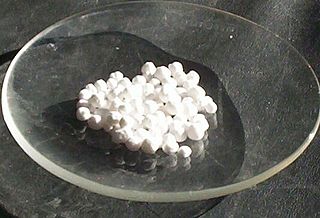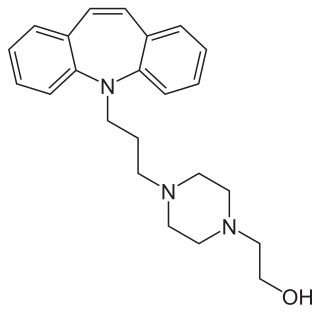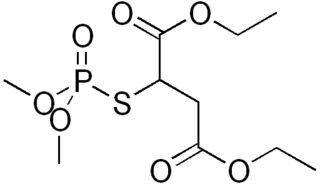A coma is a deep state of prolonged unconsciousness in which a person cannot be awakened, fails to respond normally to painful stimuli, light, or sound, lacks a normal wake-sleep cycle and does not initiate voluntary actions. Coma patients exhibit a complete absence of wakefulness and are unable to consciously feel, speak or move. Comas can be derived by natural causes, or can be medically induced.

Hypericum perforatum, known as perforate St John's-wort, is a flowering plant in the family Hypericaceae and the type species of the genus Hypericum.
The laryngeal theory is a theory in the historical linguistics of the Indo-European languages positing that:

Potassium bromide (KBr) is a salt, widely used as an anticonvulsant and a sedative in the late 19th and early 20th centuries, with over-the-counter use extending to 1975 in the US. Its action is due to the bromide ion. Potassium bromide is used as a veterinary drug, as an antiepileptic medication for dogs.

Procaine is a local anesthetic drug of the amino ester group. It is most commonly used in dental procedures to numb the area around a tooth and is also used to reduce the pain of intramuscular injection of penicillin. Owing to the ubiquity of the trade name Novocain, in some regions, procaine is referred to generically as novocaine. It acts mainly as a sodium channel blocker. Today it is used therapeutically in some countries due to its sympatholytic, anti-inflammatory, perfusion-enhancing, and mood-enhancing effects.

Sertindole, sold under the brand name Serdolect among others, is an antipsychotic medication. Sertindole was developed by the Danish pharmaceutical company Lundbeck and marketed under license by Abbott Labs. Like other atypical antipsychotics, it has activity at dopamine and serotonin receptors in the brain. It is used in the treatment of schizophrenia. It is classified chemically as a phenylindole derivative.
Hypoventilation occurs when ventilation is inadequate to perform needed respiratory gas exchange. By definition it causes an increased concentration of carbon dioxide (hypercapnia) and respiratory acidosis. Hypoventilation is not synonymous with respiratory arrest, in which breathing ceases entirely and death occurs within minutes due to hypoxia and leads rapidly into complete anoxia, although both are medical emergencies. Hypoventilation can be considered a precursor to hypoxia and its lethality is attributed to hypoxia with carbon dioxide toxicity.
Habituation is a form of non-associative learning in which an innate (non-reinforced) response to a stimulus decreases after repeated or prolonged presentations of that stimulus. Responses that habituate include those that involve the intact organism or those that involve only components of the organism. The broad ubiquity of habituation across all biologic phyla has resulted in it being called "the simplest, most universal form of learning...as fundamental a characteristic of life as DNA." Functionally-speaking, by diminishing the response to an inconsequential stimulus, habituation is thought to free-up cognitive resources to other stimuli that are associated with biologically important events. For example, organisms may habituate to repeated sudden loud noises when they learn these have no consequences. A progressive decline of a behavior in a habituation procedure may also reflect nonspecific effects such as fatigue, which must be ruled out when the interest is in habituation. Habituation is clinically relevant, as a number of neuropsychiatric conditions, including autism, schizophrenia, migraine, and Tourette's, show reductions in habituation to a variety of stimulus-types both simple (tone) and complex (faces).
An adverse effect is an undesired harmful effect resulting from a medication or other intervention, such as surgery. An adverse effect may be termed a "side effect", when judged to be secondary to a main or therapeutic effect. If it results from an unsuitable or incorrect dosage or procedure, this is called a medical error and not a complication. Adverse effects are sometimes referred to as "iatrogenic" because they are generated by a physician/treatment. Some adverse effects occur only when starting, increasing or discontinuing a treatment. Adverse effects can also be caused by placebo treatments . Using a drug or other medical intervention which is contraindicated may increase the risk of adverse effects. Adverse effects may cause complications of a disease or procedure and negatively affect its prognosis. They may also lead to non-compliance with a treatment regimen. Adverse effects of medical treatment resulted in 142,000 deaths in 2013 up from 94,000 deaths in 1990 globally.

Proto-Balto-Slavic is a reconstructed hypothetical proto-language descending from Proto-Indo-European (PIE). From Proto-Balto-Slavic, the later Balto-Slavic languages are thought to have developed, composed of sub-branches Baltic and Slavic, and including modern Lithuanian, Polish, Russian and Serbo-Croatian, among others.

In medicine, confusion is the quality or state of being bewildered or unclear. The term "acute mental confusion" is often used interchangeably with delirium in the International Statistical Classification of Diseases and Related Health Problems and the Medical Subject Headings publications to describe the pathology. These refer to the loss of orientation, or the ability to place oneself correctly in the world by time, location and personal identity. Mental confusion is sometimes accompanied by disordered consciousness and memory loss.

Stupor is the lack of critical mental function and a level of consciousness, in which an affected person is almost entirely unresponsive and responds only to intense stimuli such as pain. The word derives from the Latin stupor.

Protriptyline, sold under the brand name Vivactil among others, is a tricyclic antidepressant (TCA), specifically a secondary amine, indicated for the treatment of depression and attention-deficit hyperactivity disorder (ADHD). Uniquely among most of the TCAs, protriptyline tends to be energizing instead of sedating, and is sometimes used for narcolepsy to achieve a wakefulness-promoting effect.

Opipramol, sold under the brand name Insidon among others, is an anxiolytic and antidepressant that is used throughout Europe. Despite chemically being a tricyclic dibenzazepine (iminostilbene) derivative similar to imipramine, opipramol is not a monoamine reuptake inhibitor like most other tricyclic antidepressants, and instead, uniquely among antidepressants, acts primarily as a sigma receptor agonist. It was developed by Schindler and Blattner in 1961.

Malaoxon (Liromat, Malation oxon, Malthon oxon) is a chemical compound with the formula C10H19O7PS. More specifically, it is a phosphorothioate. It is a breakdown product of, and more toxic than, malathion.
The Slavic liquid metathesis refers to the phenomenon of metathesis of liquid consonants in the Common Slavic period in the South Slavic and West Slavic area. The closely related corresponding phenomenon of pleophony occurred in parallel, in the East Slavic languages.

Vilazodone, sold under the brand name Viibryd among others, is a medication used to treat major depressive disorder. While it was being studied for generalized anxiety disorder, such research had stopped as of 2017. It is taken by mouth.
The particles of the Proto-Indo-European language (PIE) have been reconstructed by modern linguists based on similarities found across all Indo-European languages.
Procedural sedation and analgesia (PSA) is a technique in which a sedating/dissociative medication is given, usually along with an analgesic medication, in order to perform non-surgical procedures on a patient. The overall goal is to induce a decreased level of consciousness while maintaining the patient's ability to breathe on their own. Airway protective reflexes are not compromised by this process and therefore endotracheal intubation is not required. PSA is commonly used in the emergency department, in addition to the operating-room.

An altered level of consciousness is any measure of arousal other than normal. Level of consciousness (LOC) is a measurement of a person's arousability and responsiveness to stimuli from the environment. A mildly depressed level of consciousness or alertness may be classed as lethargy; someone in this state can be aroused with little difficulty. People who are obtunded have a more depressed level of consciousness and cannot be fully aroused. Those who are not able to be aroused from a sleep-like state are said to be stuporous. Coma is the inability to make any purposeful response. Scales such as the Glasgow coma scale have been designed to measure the level of consciousness.











